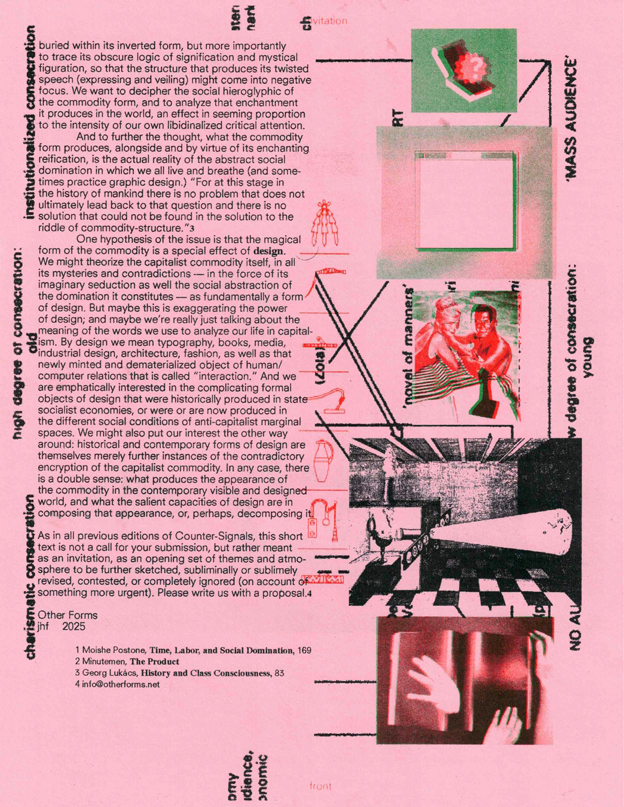Call: Counter-Signals 6
Cryptic Commodity Form in the Graphic Design Superstructure edited by Jack Henrie FisherAt first glance it appears trivial and obvious, unremarkable, an ordinary object of our everyday reality. But the more nearly we observe it, twist and turn it, and the more carefully we attend to its whispered speech, the more it reveals itself to be something strange: subtle and enigmatic, magical and enchanting. Produced in unknown and unknowable circumstances, it appears before us as a phantom, a thing but more like a graphic — as if its sensible appearance was itself an illegible logo, a visual signal from an unnameable abyss, a skewed glyph or randumbsigil, the hieroglyphic or graphic of a content that has been scrambled beyond recognition.
Everything that swarms and buzzes before us in our creepy capitalist life-world bears this illegible stamp, vibrating in tender or aggressive pulsations, like a slinky or a drone, or a plate of slime, begging for our autonomous sensory meridian response (ASMR). Everything we see, whichever way we turn, sparkles and whispers, blurred1, slurred according to the same encrypted and hypothetical animus. Everything under the sun is dancing on its own (like Robyn), but it’s upside down, like the table in Capital. The closer we get, the better we can hear the chirping, stirring speech that surrounds it, whether it’s purple prose or an objective correlative. Everything that appears within our field of vision is moving and speaking in constant structural circulation, in movements that rhyme according to the same cryptic commodity form: cloth, iron, corn (wheat), tables, books (especially books), buildings, water, flavor-blasted baked goldfish snack crackers, all-analogue slow-speed numbered remastered vinyl editions of Here Come the Warm Jets, our very labor power, you name it.
boxed and sealed
dated and processed in Russia with ah —
saaaahhh![music]
say so dirty oh
celloid sa-faction
satisfaction
[flute playing and distant shouting]
gave an existence
in experience
of many … [ruses]
the proof is —!
is surviving
hhhhhhhh![trumpet solo]
[key change]
get er rah ha ha ha ha!
[key return]the product the product the product the product
the product the product the product the product
the product the product the product the product
the product of capitalism2
… Following hotly on the heels of our runaway blockbuster Systems and their Discontents, we cordially invite you to query with us the magical form — cryptical, fantastic, occult — that our products of labor take in capitalism. With the sixth issue of Counter-Signals, we aim to pierce more deeply into, or bang a dissonant counterpoint against, the confounding appearance of the capitalist commodity. Or we mean to ride its dilating waves of weird vibrations outward, in order to not only attempt to invoke the socially mediating labor that lies buried within its inverted form, but more importantly to trace its obscure logic of signification and mystical figuration, so that the structure that produces its twisted speech (expressing and veiling) might come into negative focus. We want to decipher the social hieroglyphic of the commodity form, and to analyze that enchantment it produces in the world, an effect in seeming proportion to the intensity of our own libidinalized critical attention.
And to further the thought, what the commodity form produces, alongside and by virtue of its enchanting reification, is the actual reality of the abstract social domination in which we all live and breathe (and sometimes practice graphic design.) “For at this stage in the history of mankind there is no problem that does not ultimately lead back to that question and there is no solution that could not be found in the solution to the riddle of commodity-structure.”3
One hypothesis of the issue is that the magical form of the commodity is a special effect of design. We might theorize the capitalist commodity itself, in all its mysteries and contradictions — in the force of its imaginary seduction as well the social abstraction of the domination it constitutes — as fundamentally a form of design. But maybe this is exaggerating the power of design; and maybe we’re really just talking about the meaning of the words we use to analyze our life in capitalism. By design we mean typography, books, media, furniture, clothing, architecture, as well as that newly minted and dematerialized object of human/computer relations that is called “interaction.” And we are emphatically interested in the complicating formal objects of design that were historically produced in state socialist economies, or were or are now produced in the different social conditions of anti-capitalist marginal spaces. We might also put our interest the other way around: historical and contemporary forms of design are themselves merely further instances of the contradictory encryption of the capitalist commodity. In any case, there is a double sense: what produces the appearance of the commodity in the contemporary visible and designed world, and what the salient capacities of design are in composing that appearance, or, perhaps, decomposing it.
As in all previous editions of Counter-Signals, this short text is not a call for your submission, but rather meant as an invitation, as an opening set of themes and atmosphere to be further sketched, subliminally or sublimely revised, contested, or completely ignored (on account of something more urgent). Please write us with a proposal.4

